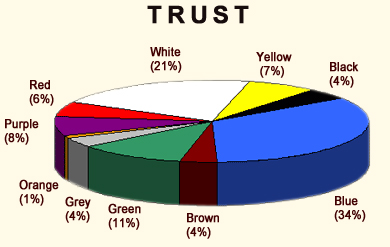So don’t let (online) sellers affect your decision by showing you what you want to see. Let’s see how color choice may affect your shopping behavior and habits – for you to be able to buy with a cool head.
Effects of Colors in Business
Facts we should also know about colors:
* Color is a powerful promotional tool;
* Colors should be trendy and catchy (use “colors that pop”);
* Between 60% and 90% of website initial assessment is based on its color.
Here is also the graphical representation of how different colors are associated with trust.
As can seen from the above table, red and orange colors are most often used to encourage your action, i.e. to prompt you to buy something or subscribe to the newsletter (and become the customer later on).
Green and blue, on the other hand, are “supporting colors” that make you feel secure and safe thus entrust the seller with your money.
Color Depends on the Season
Another way to appeal to your eye is to choose colors on occasion. Many e-shops change design from season to season to make you feel more at home. You’ll see more red/orange designs in autumn, blue/white – in winter and green websites in spring.
Besides, it is a frequently-used trick to change colors depending on the approaching holidays: green and red combination is associated with Christmas (as they symbolize Christmas tree and Santa Clause); red is often used on St Valentine’s day (as that’s the color of heart and love), orange is associated with Halloween because pumpkins are a big part of that holiday (of course, all the aforementioned associations may vary from country to country).


